The career of Italian stage and screen actress Germana Paolieri (1906-1998) flourished between the 1920s and 1980s. As a film actress, she peaked in the 1930s and early 1940s, but also in the mid-1950s. After the war, she also worked for radio and television.
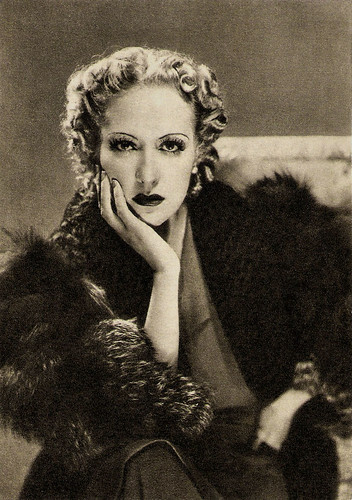
Italian postcard by Pizzi & Pizio, Milano, for Melloni - Biancherie - Telerie, Bologna. Photo: Luxardo, Roma.

Italian postcard by Rizzoli & C., Milano, 1938. Photo: Ghergo.

Italian postcard by Rizzoli & C., Milano, 1939-XVIII. Photo: Ghergo. Sent by mail in 1940.
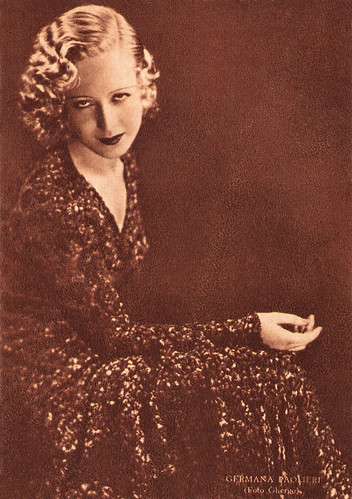
Italian postcard by Rizzoli & C., Milano, 1942-XX. Photo: Ghergo.
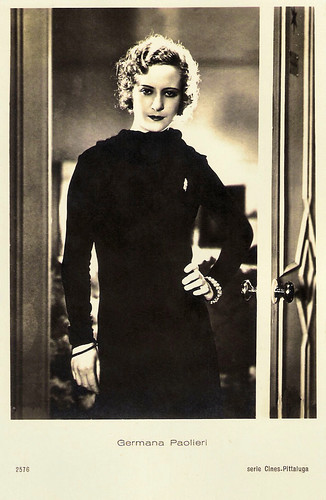
Italian postcard by B.F.F. Edit. (Casa Editrice Ballerini & Fratini, Firenze) in the series Cines-Pittaluga, no. 2576. Photo: Cines-Pittaluga.
Germana Paolieri, aka Germaine Paolieri, was born in Florence, Italy in 1906.
At a very young age, she started with a ballet class. In the 1920s she entered the theatre companies of Garibalda Niccoli, Elsa Merlini, and Dora Menichelli.
From the early 1930s on Paolieri started her career as film actress. She starred in several opera films or films on opera composers and singers such as La cantante dell'Opera/The opera singer (Nunzio Malasomma, 1932), La Wally (Guido Brignone, 1932), Giuseppe Verdi (Carmine Gallone, 1938) featuring Fosco Giachetti, L'allegro cantante/The gay singer (Gennaro Righelli, 1938), Il sogno di Butterfly/Madame Butterfly (Carmine Gallone, 1939) with Maria Cebotari as Madame Butterfly, and La Sonnambula (Piero Ballerini, 1941), a biopic on composer Vincenzo Bellini played by Roberto Villa.
Paolieri also gave a remarkable performance as Bianca Strozzi in the period piece Lorenzino de' Medici (Guido Brignone, 1935). Alexander Moissi plays Lorenzo de Medici whose sweetheart (Paolieri) is cherished by the perfidious Duke Alessandro (Camillo Pilotto) as well.
Paolieri also played the wife of the title character in Luciano Serra pilota/Luciano Serra, Pilot (Goffredo Alessandrini, 1938). This highly successful film starred Amedeo Nazzari as an ex-pilot who has abandoned wife, child, and fatherland but is called to duty when years after his son (Roberto Villa) crashes with a plane in Africa and is captured by enemies.
In La forza bruta/Brute Force (Carlo Ludovico Bragaglia, 1941), Paolieri played a trapeze artist opposite Juan De Landa, Rossano Brazzi and Maria Mercader.
Other memorable titles with Paolieri are Torna caro ideal!/Return, dear ideal (Guido Brignone, 1939) with Claudio Gora, and Kean (Guido Brignone, 1940) with Rossano Brazzi in his first major role as the actor Edmund Kean who competes with a prince for the hand of a married lady, played by Paolieri.
Furthermore, she acted opposite Ruggero Ruggeri in La gerla di papà Martin (Mario Bonnard, 1940) and Se son matti non li vogliamo (Esodo Pratelli, 1941). And Paolieri played the title role in the historical melodrama Pia de' Tolomei (Esodo Pratelli, 1941).
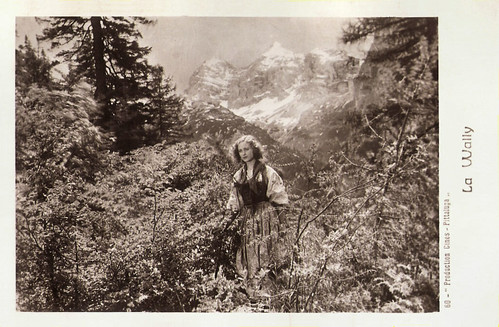
Italian postcard by G.B. Falci, Milano, no. 60. Photo: Cines-Pittaluga. Germana Paolieri as Wally La Wally (Guido Brignone, 1932).

Italian postcard by Cines-Pittaluga, no. 6. Germana Paolieri and Isa Pola in La cantante dell'opera/The opera singer (Nunzio Malasomma, 1932).
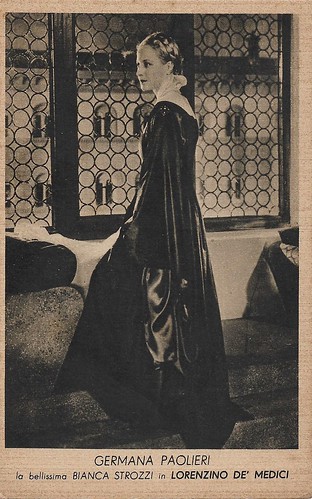
Italian postcard by Ed. L. de Rosio, Milano. Photo: Manenti Film. Germana Paolieri as the beautiful Bianca Strozzi in Lorenzino de' Medici/The Magnificent Rogue (Guido Brignone, 1935).
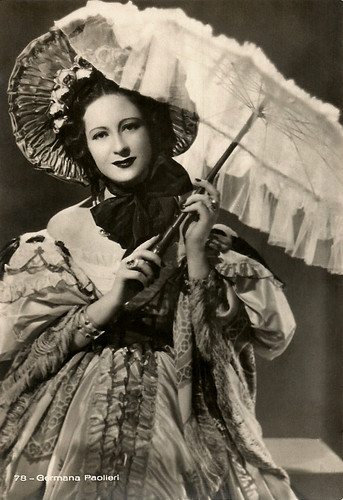
Italian postcard by ASER (Aldo Scarmiglia Edizioni, Roma), no. 78. Photo: Bertazzini. Publicity still for La Sonnambula (Piero Ballerini, 1941).
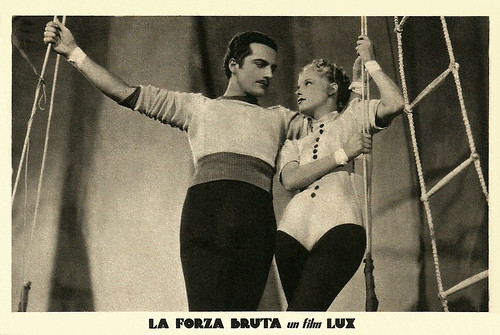
Italian postcard by Rotocalco Dagnino, Torino. Photo: Lux production. Publicity still for La forza bruta/Brute Force (Carlo Ludovico Bragaglia, 1941) with Rossano Brazzi.

German postcard by Film-Foto-Verlag, no. A 3856/1, 1941-1944. Photo: Baumann / Ufa. Germana Paolieri in Immensee - Ein deutsches Volkslied/Immensee - A German folk song (Veit Harlan, 1943).
During the war years Germana Paolieri also worked in Italy for the Ufa. She had a supporting role as Lauretta in Veit Harlan’s extremely romantic film Immensee - Ein deutsches Volkslied/Immensee (1943), starring Carl Raddatz and Kristina Söderbaum.
After the war, Paolieri pretty easily continued filming in mainly conventional dramas and comedies. In 1947-1948 she returned to the stage to play Lady Capulet in William Shakespeare’s 'Romeo and Juliet', directed by Renato Simoni and staged at the Teatro Romano in Verona. In 1948 Paolieri starred in the play 'Cristo ha ucciso' (Christ has killed) by Gian Paolo Callegari, directed by Guido Salvini at the Teatro La Fenice in Venice.
In 1949 Paolieri went back to the film set and had an intense film career in particular during the mid-1950s. She worked with directors like Vittorio De Sica, Vittorio Cottafavi, Augusto Genina, Carlo Borghesio and Caro Campogalliani.
In the 1960s she played a.o. the mother of Gérard Blain in Francesco Maselli’s cynical I delfini/The Dauphins (1960).
Her final film role was a small part in Sidney Lumet’s The Appointment (1969) with Omar Sharif and Anouk Aimée.
In the 1950s Paolieri was a member of the theatre companies of Ruggero Ruggeri (as first actress), the Piccolo Teatro of Palermo, and the Teatro stabile of Emilia-Romagna. She was also active on RAI radio in 'Prime piogge' (First rains) by Enrico Pea, directed by Alberto Casella and broadcasted in 1957, while in the same year she was also on RAI TV in Oscar Wilde’s Lady Windermere’s Fan, directed by Claudio Fino.
Later she acted in TV series such as Scaramouche (Daniele D'Anza, 1965), Oblomov (Claudio Fino, 1966), Dossier Mata Hari (Mario Landi, 1967), I promessi sposi (Sandro Bolchi, 1967), and Madame Bovary (Daniele D'Anza, 1968) featuring Carla Gravina. Her final screen appearance was in the TV film Adua (Dante Guardamagna, 1981).
Germana Paolieri died in Montecatini Terme, in 1998. She was 91. Paolieri lies buried in the cemetery of Santa Croce sull'Arno (Pisa).

Italian postcard in the Cines-Pittaluga Series by B.F.F. Edit. (Casa Editrice Ballerini & Fratini, Firenze), no. 2580. Photo: Cines-Pittaluga.
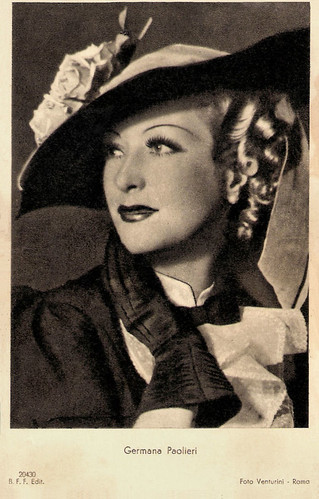
Italian postcard by B.F.F. Edit. (Casa Editrice Ballerini & Fratini, Firenze), no. 20430. Photo: Venturini, Roma.
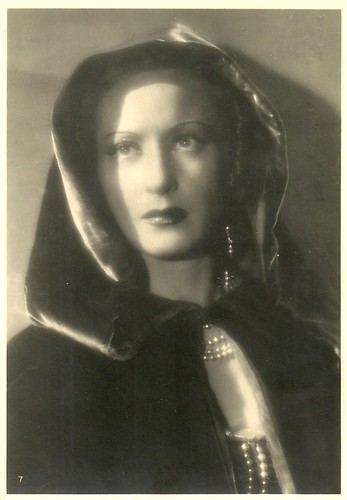
Italian postcard by ASER, 1941. Photo: Pesce / Scalera Film.
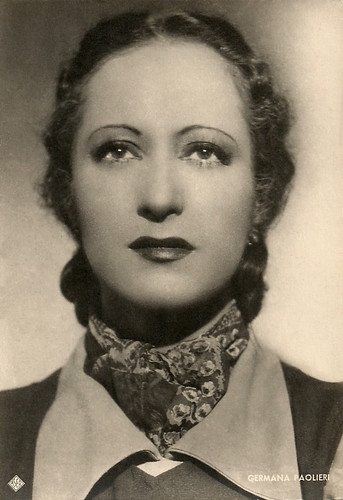
Italian postcard by ASER (A. Scarmiglia Edizioni Roma), no. 7. Photo: Vaselli / Iuventus Film.
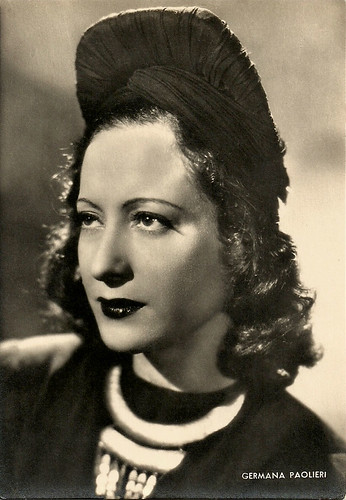
Italian postcard by ASER (Aldo Scarmiglia Edizioni Roma), no. 73. Photo: Bertazzini.
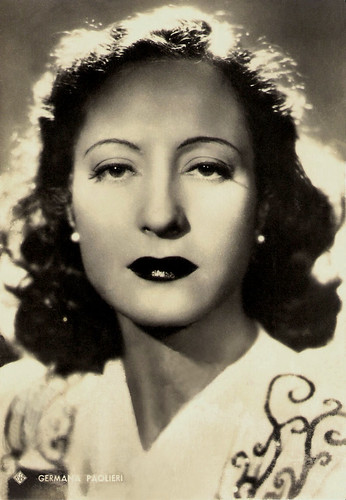
Italian postcard by ASER (A. Scarmiglia Ed., Roma), no. 78. Photo: Bertazzini.

Italian postcard by ASER (Aldo Scarmiglia Edizioni, Roma), no. 156. Photo: Germana Paolieri in probably Pia De' Tolomei (1941).
Sources: Wikipedia (Italian) and IMDb.
This post was last updated on 21 June 2020.

Italian postcard by Pizzi & Pizio, Milano, for Melloni - Biancherie - Telerie, Bologna. Photo: Luxardo, Roma.

Italian postcard by Rizzoli & C., Milano, 1938. Photo: Ghergo.

Italian postcard by Rizzoli & C., Milano, 1939-XVIII. Photo: Ghergo. Sent by mail in 1940.

Italian postcard by Rizzoli & C., Milano, 1942-XX. Photo: Ghergo.

Italian postcard by B.F.F. Edit. (Casa Editrice Ballerini & Fratini, Firenze) in the series Cines-Pittaluga, no. 2576. Photo: Cines-Pittaluga.
Opera Films
Germana Paolieri, aka Germaine Paolieri, was born in Florence, Italy in 1906.
At a very young age, she started with a ballet class. In the 1920s she entered the theatre companies of Garibalda Niccoli, Elsa Merlini, and Dora Menichelli.
From the early 1930s on Paolieri started her career as film actress. She starred in several opera films or films on opera composers and singers such as La cantante dell'Opera/The opera singer (Nunzio Malasomma, 1932), La Wally (Guido Brignone, 1932), Giuseppe Verdi (Carmine Gallone, 1938) featuring Fosco Giachetti, L'allegro cantante/The gay singer (Gennaro Righelli, 1938), Il sogno di Butterfly/Madame Butterfly (Carmine Gallone, 1939) with Maria Cebotari as Madame Butterfly, and La Sonnambula (Piero Ballerini, 1941), a biopic on composer Vincenzo Bellini played by Roberto Villa.
Paolieri also gave a remarkable performance as Bianca Strozzi in the period piece Lorenzino de' Medici (Guido Brignone, 1935). Alexander Moissi plays Lorenzo de Medici whose sweetheart (Paolieri) is cherished by the perfidious Duke Alessandro (Camillo Pilotto) as well.
Paolieri also played the wife of the title character in Luciano Serra pilota/Luciano Serra, Pilot (Goffredo Alessandrini, 1938). This highly successful film starred Amedeo Nazzari as an ex-pilot who has abandoned wife, child, and fatherland but is called to duty when years after his son (Roberto Villa) crashes with a plane in Africa and is captured by enemies.
In La forza bruta/Brute Force (Carlo Ludovico Bragaglia, 1941), Paolieri played a trapeze artist opposite Juan De Landa, Rossano Brazzi and Maria Mercader.
Other memorable titles with Paolieri are Torna caro ideal!/Return, dear ideal (Guido Brignone, 1939) with Claudio Gora, and Kean (Guido Brignone, 1940) with Rossano Brazzi in his first major role as the actor Edmund Kean who competes with a prince for the hand of a married lady, played by Paolieri.
Furthermore, she acted opposite Ruggero Ruggeri in La gerla di papà Martin (Mario Bonnard, 1940) and Se son matti non li vogliamo (Esodo Pratelli, 1941). And Paolieri played the title role in the historical melodrama Pia de' Tolomei (Esodo Pratelli, 1941).

Italian postcard by G.B. Falci, Milano, no. 60. Photo: Cines-Pittaluga. Germana Paolieri as Wally La Wally (Guido Brignone, 1932).

Italian postcard by Cines-Pittaluga, no. 6. Germana Paolieri and Isa Pola in La cantante dell'opera/The opera singer (Nunzio Malasomma, 1932).

Italian postcard by Ed. L. de Rosio, Milano. Photo: Manenti Film. Germana Paolieri as the beautiful Bianca Strozzi in Lorenzino de' Medici/The Magnificent Rogue (Guido Brignone, 1935).

Italian postcard by ASER (Aldo Scarmiglia Edizioni, Roma), no. 78. Photo: Bertazzini. Publicity still for La Sonnambula (Piero Ballerini, 1941).

Italian postcard by Rotocalco Dagnino, Torino. Photo: Lux production. Publicity still for La forza bruta/Brute Force (Carlo Ludovico Bragaglia, 1941) with Rossano Brazzi.

German postcard by Film-Foto-Verlag, no. A 3856/1, 1941-1944. Photo: Baumann / Ufa. Germana Paolieri in Immensee - Ein deutsches Volkslied/Immensee - A German folk song (Veit Harlan, 1943).
Extremely Romantic
During the war years Germana Paolieri also worked in Italy for the Ufa. She had a supporting role as Lauretta in Veit Harlan’s extremely romantic film Immensee - Ein deutsches Volkslied/Immensee (1943), starring Carl Raddatz and Kristina Söderbaum.
After the war, Paolieri pretty easily continued filming in mainly conventional dramas and comedies. In 1947-1948 she returned to the stage to play Lady Capulet in William Shakespeare’s 'Romeo and Juliet', directed by Renato Simoni and staged at the Teatro Romano in Verona. In 1948 Paolieri starred in the play 'Cristo ha ucciso' (Christ has killed) by Gian Paolo Callegari, directed by Guido Salvini at the Teatro La Fenice in Venice.
In 1949 Paolieri went back to the film set and had an intense film career in particular during the mid-1950s. She worked with directors like Vittorio De Sica, Vittorio Cottafavi, Augusto Genina, Carlo Borghesio and Caro Campogalliani.
In the 1960s she played a.o. the mother of Gérard Blain in Francesco Maselli’s cynical I delfini/The Dauphins (1960).
Her final film role was a small part in Sidney Lumet’s The Appointment (1969) with Omar Sharif and Anouk Aimée.
In the 1950s Paolieri was a member of the theatre companies of Ruggero Ruggeri (as first actress), the Piccolo Teatro of Palermo, and the Teatro stabile of Emilia-Romagna. She was also active on RAI radio in 'Prime piogge' (First rains) by Enrico Pea, directed by Alberto Casella and broadcasted in 1957, while in the same year she was also on RAI TV in Oscar Wilde’s Lady Windermere’s Fan, directed by Claudio Fino.
Later she acted in TV series such as Scaramouche (Daniele D'Anza, 1965), Oblomov (Claudio Fino, 1966), Dossier Mata Hari (Mario Landi, 1967), I promessi sposi (Sandro Bolchi, 1967), and Madame Bovary (Daniele D'Anza, 1968) featuring Carla Gravina. Her final screen appearance was in the TV film Adua (Dante Guardamagna, 1981).
Germana Paolieri died in Montecatini Terme, in 1998. She was 91. Paolieri lies buried in the cemetery of Santa Croce sull'Arno (Pisa).

Italian postcard in the Cines-Pittaluga Series by B.F.F. Edit. (Casa Editrice Ballerini & Fratini, Firenze), no. 2580. Photo: Cines-Pittaluga.

Italian postcard by B.F.F. Edit. (Casa Editrice Ballerini & Fratini, Firenze), no. 20430. Photo: Venturini, Roma.

Italian postcard by ASER, 1941. Photo: Pesce / Scalera Film.

Italian postcard by ASER (A. Scarmiglia Edizioni Roma), no. 7. Photo: Vaselli / Iuventus Film.

Italian postcard by ASER (Aldo Scarmiglia Edizioni Roma), no. 73. Photo: Bertazzini.

Italian postcard by ASER (A. Scarmiglia Ed., Roma), no. 78. Photo: Bertazzini.

Italian postcard by ASER (Aldo Scarmiglia Edizioni, Roma), no. 156. Photo: Germana Paolieri in probably Pia De' Tolomei (1941).
Sources: Wikipedia (Italian) and IMDb.
This post was last updated on 21 June 2020.
No comments:
Post a Comment